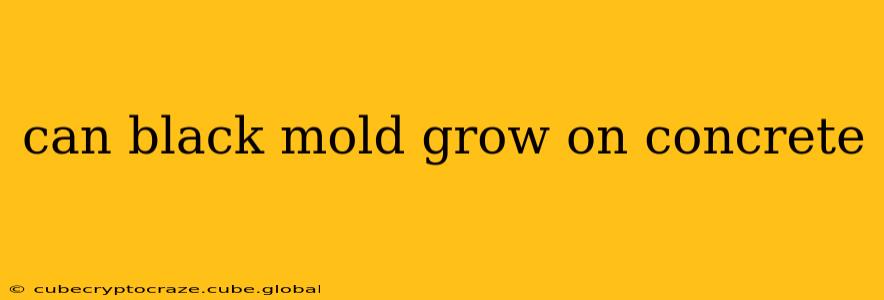Can Black Mold Grow on Concrete? A Comprehensive Guide
Black mold, or Stachybotrys chartarum, is a type of fungus that thrives in damp, dark environments. While often associated with drywall and wood, many wonder: can black mold grow on concrete? The short answer is yes, but it's not as straightforward as it might seem. Concrete's porous nature and susceptibility to moisture make it a potential breeding ground, but several factors influence the likelihood of black mold growth. This guide delves into the complexities of mold growth on concrete, answering common questions and providing practical advice.
What Conditions Are Necessary for Mold to Grow on Concrete?
Mold, including black mold, requires three essential elements to flourish: moisture, a food source, and the right temperature. Concrete, while seemingly inert, can provide all three.
-
Moisture: This is the biggest factor. Leaks, flooding, high humidity, and even condensation can saturate concrete, creating the perfect breeding ground for mold spores. Cracks and gaps in the concrete allow moisture to penetrate deeper, further exacerbating the problem.
-
Food Source: Concrete itself isn't a food source, but dust, dirt, organic matter (like decaying leaves or wood debris), and even drywall dust that settles on the concrete surface can provide nourishment for mold.
-
Temperature: Mold thrives in temperatures between 77°F and 86°F (25°C and 30°C). While concrete can retain heat, the ambient temperature of the surrounding environment plays a crucial role.
Can Black Mold Grow on Concrete That's Always Dry?
No. Black mold, like all mold, needs moisture to survive and reproduce. If the concrete remains consistently dry, the risk of black mold growth is significantly reduced. Regular cleaning and proper ventilation can help maintain dryness.
How Does Concrete's Porosity Affect Mold Growth?
Concrete is a porous material, meaning it has tiny pores that allow water to penetrate. This porosity allows moisture to be absorbed and retained, providing a hospitable environment for mold spores to germinate and grow, especially in areas with poor drainage or inadequate ventilation. Highly porous concrete is therefore more susceptible to mold growth than less porous varieties.
What are the Signs of Black Mold Growth on Concrete?
Identifying black mold on concrete can be challenging as it can blend in with the concrete's color, especially in darker areas. However, some key signs to watch out for include:
- Discoloration: Look for dark patches, often black or dark green, that appear slimy or fuzzy.
- Musty Odor: A distinct musty or earthy smell can indicate mold growth, even before visible signs appear.
- Visible Mold Growth: In severe cases, you might see visible fuzzy or slimy patches of mold.
How Can I Prevent Black Mold Growth on Concrete?
Prevention is always better than cure. Here are some effective strategies to prevent black mold growth on concrete:
- Maintain Dryness: Address any leaks or sources of moisture promptly. Ensure proper drainage and ventilation in areas prone to dampness.
- Regular Cleaning: Clean concrete surfaces regularly to remove dust, dirt, and organic matter that can provide food for mold.
- Sealing: Consider sealing porous concrete surfaces to reduce moisture penetration. This is particularly crucial in basements or areas prone to moisture.
- Ventilation: Good ventilation helps to reduce humidity and prevent mold growth. Use dehumidifiers in damp areas.
What Should I Do If I Find Black Mold on Concrete?
If you suspect black mold growth on your concrete, don't attempt to clean it yourself, especially if the affected area is large. Black mold can be hazardous to your health. Contact a professional mold remediation specialist. They have the expertise and equipment to safely remove the mold and prevent its recurrence. They can also determine the extent of the problem and recommend appropriate solutions to prevent future growth.
By understanding the conditions that promote black mold growth and implementing preventative measures, you can significantly reduce the risk of this harmful fungus taking root on your concrete surfaces. Remember, early detection and professional intervention are crucial for maintaining a healthy and safe environment.
